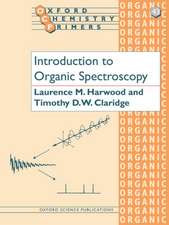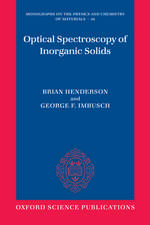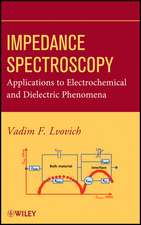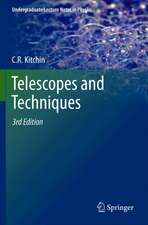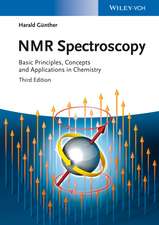Handbook of Molecular Force Spectroscopy
Editat de Aleksandr Noyen Limba Engleză Paperback – 4 noi 2010
Molecular force spectroscopy measurements have been very important for studies of adhesion and friction forces, where they provided the first truly nanoscale capabilities. Force spectroscopy has been instrumental in understanding mechanical properties and nanoscale dynamics of polymer systems from elasticity to nanoscale phase segregation. In biophysics, applications range from probing protein folding to direct mapping of intermolecular interaction potentials. This volume presents a review of modern force spectroscopy, including fundamentals of intermolecular forces, technical aspects of the force measurements, and practical applications. The Handbook begins with a review of fundamental physics of loading single and multiple chemical bonds on the nanometer scale with a discussion of thermodynamic and kinetic models of binding forces and dissipation effects in nanoscale molecular contacts, covers practical aspects of modern single-molecule level techniques, and concludes with applications of force spectroscopy to chemical and biological processes. Computer modeling of force spectroscopy experiments is addressed as well. In sum, Handbook of Molecular Force Spectroscopy is a comprehensive, authoritative guide to planning, understanding, and analyzing modern molecular force spectroscopy experiments with an emphasis on biophysical research.
| Toate formatele și edițiile | Preț | Express |
|---|---|---|
| Paperback (1) | 949.42 lei 6-8 săpt. | |
| Springer Us – 4 noi 2010 | 949.42 lei 6-8 săpt. | |
| Hardback (1) | 955.70 lei 6-8 săpt. | |
| Springer Us – 4 dec 2007 | 955.70 lei 6-8 săpt. |
Preț: 949.42 lei
Preț vechi: 1157.82 lei
-18% Nou
Puncte Express: 1424
Preț estimativ în valută:
181.68€ • 194.27$ • 151.47£
181.68€ • 194.27$ • 151.47£
Carte tipărită la comandă
Livrare economică 18 aprilie-02 mai
Preluare comenzi: 021 569.72.76
Specificații
ISBN-13: 9781441943231
ISBN-10: 1441943234
Pagini: 320
Ilustrații: XII, 300 p. 150 illus.
Dimensiuni: 178 x 254 x 17 mm
Greutate: 0.56 kg
Ediția:Softcover reprint of hardcover 1st ed. 2008
Editura: Springer Us
Colecția Springer
Locul publicării:New York, NY, United States
ISBN-10: 1441943234
Pagini: 320
Ilustrații: XII, 300 p. 150 illus.
Dimensiuni: 178 x 254 x 17 mm
Greutate: 0.56 kg
Ediția:Softcover reprint of hardcover 1st ed. 2008
Editura: Springer Us
Colecția Springer
Locul publicării:New York, NY, United States
Public țintă
ResearchCuprins
Surface force apparatus measurements of molecular forces in biological adhesion
(Deborah Leckband, Univ. of Illinois, Urbana-Champaign).- Force spectroscopy with optical and magnetic tweezers (Richard Conroy, Harvard University).- Chemical Force Microscopy 1: Nanoscale probing of fundamental chemical interactions (Aleksandr Noy, LLNL, Dmitry V. Vezenov, Harvard University, and Charles M. Lieber, Harvard University).- Chemical Force Microscopy 2: Interactions in complex molecular assemblies (Dmitry V. Vezenov, Harvard University, Aleksandr Noy, LLNL, and Charles M. Lieber, Harvard University).- Dynamic force spectroscopy with the atomic force microscope (Phil Williams, University of Nottingham).- Simulation in force spectroscopy (David L. Patrick, Western Washington University).- Probe tip functionalization: applications to chemical force microscopy (Craig D. Blanchard, Albert Loui, and Timothy V. Ratto, LLNL).- The dynamical response of proteins under force.- (Kirstine L. Anderson, Sheena E. Radford, D. Alastair Smith, and David J. Brockwell, University of Leeds).- Counting and breaking single bonds: Dynamic force spectroscopy in tethered single molecule systems (Todd A. Sulchek, Raymond W. Friddle, and Aleksandr Noy, LLNL).- Direct mapping of intermolecular interaction potentials (Paul D. Ashby, MIT)
(Deborah Leckband, Univ. of Illinois, Urbana-Champaign).- Force spectroscopy with optical and magnetic tweezers (Richard Conroy, Harvard University).- Chemical Force Microscopy 1: Nanoscale probing of fundamental chemical interactions (Aleksandr Noy, LLNL, Dmitry V. Vezenov, Harvard University, and Charles M. Lieber, Harvard University).- Chemical Force Microscopy 2: Interactions in complex molecular assemblies (Dmitry V. Vezenov, Harvard University, Aleksandr Noy, LLNL, and Charles M. Lieber, Harvard University).- Dynamic force spectroscopy with the atomic force microscope (Phil Williams, University of Nottingham).- Simulation in force spectroscopy (David L. Patrick, Western Washington University).- Probe tip functionalization: applications to chemical force microscopy (Craig D. Blanchard, Albert Loui, and Timothy V. Ratto, LLNL).- The dynamical response of proteins under force.- (Kirstine L. Anderson, Sheena E. Radford, D. Alastair Smith, and David J. Brockwell, University of Leeds).- Counting and breaking single bonds: Dynamic force spectroscopy in tethered single molecule systems (Todd A. Sulchek, Raymond W. Friddle, and Aleksandr Noy, LLNL).- Direct mapping of intermolecular interaction potentials (Paul D. Ashby, MIT)
Recenzii
From the reviews:
"A series of ten chapters on various aspects of force spectroscopy, each written by an expert in the field. This book … aims ‘to present a series of topics that discuss fundamental concepts and basic methodology used to perform and understand force spectroscopy experiments and illustrate them using examples from current and past research.’ This work would represent a good introduction to the area for anyone wishing to know more about this increasingly important subject. Summing Up: Highly recommended. Upper-division undergraduate through professional collections." (A. Fry, CHOICE, Vol. 45 (10), June, 2008)
"A broad overview of core principles of force spectroscopy is of considerable utility and timeliness. Aleksandr Noy … has done an admirable job of assembling such an overview as well as providing insight into likely new directions of research. … a timely and useful summary of fundamental aspects of molecular force spectroscopy, and I believe it would make a worthwhile addition to any good scientific library. New research groups that are entering this field would be well advised to study this handbook … ." (Matthew F. Paige, Journal of the American Chemical Society, Vol. 130 (26), 2008)
"In this nicely produced volume, one of the subject’s key architects and proponents presents an extremely timely and effective summary of the field. The content is well judged … . Overall, this book represents a very worthwhile and up-to-date introduction to an exciting new field of optics." (Optics and Photonics News, July/August, 2008)
"A series of ten chapters on various aspects of force spectroscopy, each written by an expert in the field. This book … aims ‘to present a series of topics that discuss fundamental concepts and basic methodology used to perform and understand force spectroscopy experiments and illustrate them using examples from current and past research.’ This work would represent a good introduction to the area for anyone wishing to know more about this increasingly important subject. Summing Up: Highly recommended. Upper-division undergraduate through professional collections." (A. Fry, CHOICE, Vol. 45 (10), June, 2008)
"A broad overview of core principles of force spectroscopy is of considerable utility and timeliness. Aleksandr Noy … has done an admirable job of assembling such an overview as well as providing insight into likely new directions of research. … a timely and useful summary of fundamental aspects of molecular force spectroscopy, and I believe it would make a worthwhile addition to any good scientific library. New research groups that are entering this field would be well advised to study this handbook … ." (Matthew F. Paige, Journal of the American Chemical Society, Vol. 130 (26), 2008)
"In this nicely produced volume, one of the subject’s key architects and proponents presents an extremely timely and effective summary of the field. The content is well judged … . Overall, this book represents a very worthwhile and up-to-date introduction to an exciting new field of optics." (Optics and Photonics News, July/August, 2008)
Textul de pe ultima copertă
"...Noy's Handbook of Molecular Force Spectroscopy is both a timely and useful summary of fundamental aspects of molecular force spectroscopy, and I believe it would make a worthwhile addition to any good scientific library. New research groups that are entering this field would be well advisedto study this handbook in detail before venturing into the exciting and challenging world of molecular force spectroscopy." Matthew F. Paige, University of Saskatchewan, Journal of the American Chemical Society
Modern materials science and biophysics are increasingly focused on studying and controlling intermolecular interactions on the single-molecule level. Molecular force spectroscopy was developed in the past decade as the result of several unprecedented advances in the capabilities of modern scientific instrumentation, and defines a number of techniques that use mechanical force measurements to study interactions between single molecules and molecular assemblies in chemical and biological systems. Examples of these techniques, which typically target a specific range of experimental systems and geometries, include atomic force microscopy, optical tweezers, surface forces apparatus, and magnetic tweezers.
With contributions by internationally renowned scientists, Handbook of Molecular Force Spectroscopy is a comprehensive, state-of-the-art review of modern force spectroscopy, including fundamentals of intermolecular forces, technical aspects of the force measurements, and practical applications. The Handbook presents reviews of fundamental physical concepts of loading single and multiple chemical bonds on the nanometer scale, covers practical aspects of modern single-molecule level techniques, and describes several representative applications of force spectroscopy to the study of chemical and biological processes. Computer modeling of force spectroscopy experiments is addressed as well. In sum,this volume is an authoritative guide to planning, understanding, and analyzing modern molecular force spectroscopy experiments with an emphasis on biophysical research.
Modern materials science and biophysics are increasingly focused on studying and controlling intermolecular interactions on the single-molecule level. Molecular force spectroscopy was developed in the past decade as the result of several unprecedented advances in the capabilities of modern scientific instrumentation, and defines a number of techniques that use mechanical force measurements to study interactions between single molecules and molecular assemblies in chemical and biological systems. Examples of these techniques, which typically target a specific range of experimental systems and geometries, include atomic force microscopy, optical tweezers, surface forces apparatus, and magnetic tweezers.
With contributions by internationally renowned scientists, Handbook of Molecular Force Spectroscopy is a comprehensive, state-of-the-art review of modern force spectroscopy, including fundamentals of intermolecular forces, technical aspects of the force measurements, and practical applications. The Handbook presents reviews of fundamental physical concepts of loading single and multiple chemical bonds on the nanometer scale, covers practical aspects of modern single-molecule level techniques, and describes several representative applications of force spectroscopy to the study of chemical and biological processes. Computer modeling of force spectroscopy experiments is addressed as well. In sum,this volume is an authoritative guide to planning, understanding, and analyzing modern molecular force spectroscopy experiments with an emphasis on biophysical research.
Caracteristici
Provides an authoritative guide to planning, understanding, and analyzing modern molecular force spectroscopy experiments Presents state-of-the-art research at the nanoscale and single-molecule levels with an emphasis on biophysics Addresses computer modeling of force spectroscopy experiments Includes supplementary material: sn.pub/extras


